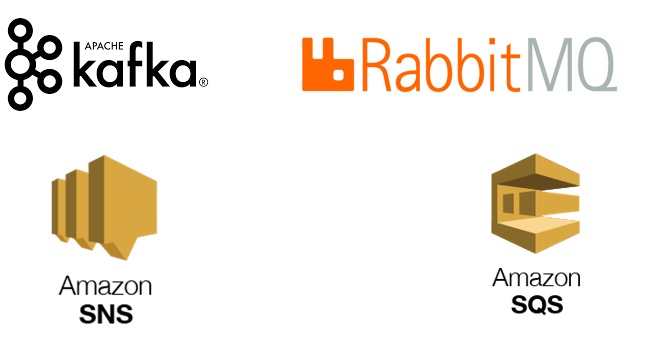In the world of distributed systems and microservices, efficient communication between services is crucial. Apache Kafka, AWS Simple Notification Service (SNS), and AWS Simple Queue Service (SQS) are three popular solutions that address the messaging and event streaming needs of modern applications. In this blog post, we will delve into the details of each platform, highlighting their features, use cases, and differences.
Overview on Apache Kafka vs RabbitMQ vs AWS SNS and SQS
Apache Kafka: Apache Kafka is an open-source distributed event streaming platform known for its high-throughput, fault-tolerance, and scalability. It was originally developed by LinkedIn and later open-sourced.
- Publish-Subscribe Model: Kafka follows a publish-subscribe messaging model where producers publish messages to topics, and consumers subscribe to those topics.
- Scalability: Kafka is designed for horizontal scalability, allowing it to handle large amounts of data and traffic. It can be easily distributed across multiple nodes to form a cluster.
- Fault-Tolerance: Kafka ensures fault-tolerance by replicating data across multiple broker nodes. This ensures that data is not lost even if some nodes fail.
- Use Cases: Kafka is ideal for scenarios requiring real-time data streaming, such as log aggregation, event sourcing, and building data pipelines.
RabbitMQ: RabbitMQ, an open-source message broker, facilitates seamless communication in distributed systems. Developed in Erlang, it implements the Advanced Message Queuing Protocol (AMQP), serving as a robust intermediary for message exchange. RabbitMQ enhances the scalability, reliability, and flexibility of communication in diverse architectural setups.
- Message Queues: RabbitMQ introduces queues, enabling asynchronous communication between producers and consumers. This decoupling prevents overload scenarios and supports efficient, asynchronous message handling.
- Exchange Mechanisms: Different exchange types, like direct, fanout, topic, and headers, provide flexibility in routing messages within the system, catering to diverse messaging patterns.
- Publish-Subscribe Model: Supporting a publish-subscribe model, RabbitMQ enables multiple consumers to receive messages from a single publisher, enhancing scalability and flexibility in message distribution.
- Reliability and Durability: RabbitMQ ensures message durability through the option to mark queues and messages as durable, critical for maintaining data integrity during unexpected failures.
- Clustering: RabbitMQ supports clustering, allowing nodes to form a cluster and operate as a single logical broker. Clustering enhances reliability, fault-tolerance, and scalability for high-performance deployments.
AWS SNS: AWS Simple Notification Service (SNS) is a fully managed notification service that enables the distribution of messages to a distributed set of subscribers.
- Publish-Subscribe and Point-to-Point: SNS supports both publish-subscribe and point-to-point communication models. It allows you to send messages to a topic, and subscribers can receive those messages.
- Ease of Use: SNS is a fully managed service, which means AWS takes care of the underlying infrastructure. It is easy to set up and integrates seamlessly with other AWS services.
- Multi-Protocol Support: SNS supports multiple protocols such as HTTP, HTTPS, email, and more, making it versatile for different communication needs.
- Use Cases: SNS is suitable for applications that require push notifications, event notifications, and messaging among distributed components.
AWS SQS: AWS Simple Queue Service (SQS) is a fully managed message queuing service that enables decoupling of the components of a cloud application.
- Queue-Based Model: SQS follows a queue-based messaging model. Messages are sent to a queue by producers and consumed by consumers. This decouples the components, allowing for better scalability and fault isolation.
- Scalability: SQS automatically scales based on the number of messages in the queue. It can handle varying workloads without manual intervention.
- Visibility Timeout: SQS provides a visibility timeout feature that prevents multiple consumers from processing the same message simultaneously, ensuring that a message is processed by only one consumer at a time.
- Use Cases: SQS is suitable for scenarios where message order is important, and you need a reliable and scalable message queue. It is commonly used in microservices architectures.
Differences between Apache Kafka vs RabbitMQ vs Amazon SNS and SQS
| Feature | Apache Kafka | RabbitMQ | AWS SNS | AWS SQS |
|---|---|---|---|---|
| Messaging Model | Publish-Subscribe | Multiple models including Publish-Subscribe, Point-to-Point, Routing | Publish-Subscribe and Point-to-Point | Queue-Based |
| Ease of Use | Requires operational effort; not fully managed | Fully managed; easy to set up | Fully managed; easy to set up | Fully managed; easy to set up |
| Scalability | Horizontal scalability with cluster formation | Horizontal scalability with clustering and federation | Scales horizontally based on demand | Horizontal scalability based on the number of messages |
| Fault-Tolerance | Replication of data across multiple broker nodes | Clustering for fault-tolerance and high availability | Relies on underlying AWS infrastructure for reliability | Replication of messages for fault tolerance |
| Protocols Supported | Custom protocols (Kafka protocol) | AMQP, MQTT, STOMP, custom protocols | HTTP, HTTPS, email, and more | Custom protocols (SQS protocol) |
| Message Order | Preserves order of messages within a partition | Preserves order within a queue | Order not guaranteed; depends on the use case | Order not guaranteed; depends on the use case |
| Use Cases | Real-time event streaming, log aggregation, data pipelines | Flexible use cases including message brokering, task distribution | Push notifications, event-driven architectures | Microservices architectures, message order critical |
Choosing between Apache Kafka, RabbitMQ, AWS SNS, and AWS SQS depends on the specific requirements of your application. Kafka excels in event streaming, RabbitMQ is versatile for various messaging patterns, SNS is great for push notifications, and SQS is ideal for reliable and decoupled message queuing in microservices architectures. Evaluate these platforms based on factors such as messaging models, ease of use, scalability, fault-tolerance, and use cases to make an informed decision for your application architecture.












